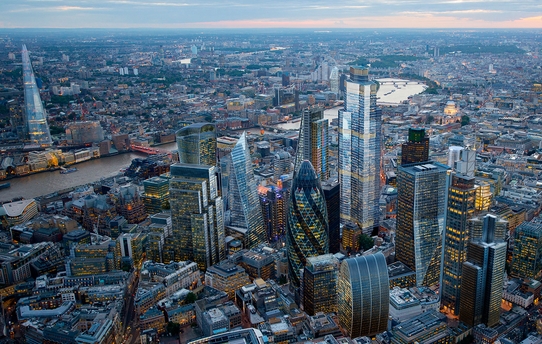22 Bishopsgate
22 Bishopsgate is the site of the former Pinnacle development.
The Pinnacle was designed in 2003 and granted planning permission in April 2006. Construction work started in 2008 but following the credit crunch, was abandoned in 2012, leaving just a seven-storey concrete core construction, referred to disparagingly as 'the Stump.'
The site, at the centre of the City of London’s cluster of tall buildings, was acquired for £300m in February 2015 by developer Lipton Rogers, funded by investors led by Axa Real Estate.
Designs by PLP Architecture showed 1.4m sq. feet of net usable space, in a 62 storey, 278 m tall tower; accommodating more floor-space than the original Pinnacle, but 10 m shorter. A planning application was submitted in July 2015 and was approved by the City of London in November 2015, backed by the then-Mayor Boris Johnson.
Sir Stuart Lipton said: “The Mayor has recognised 22 Bishopsgate as a major contribution to the on-going vitality of the City of London with a distinguished and interesting building that includes a number of new innovations designed to put the health and wellness of people first and which aims to be the first building in London to adopt the new Delos WELL building standard.”
However, the proposals were not without controversy, with the design being been criticised for over-occupying the site and for visually drawing together its neighbouring towers into a single lump.
Progress was delayed following the Brexit vote, but a decision to proceed was finally taken in October 2016, with Brookfield Multiplex expected to be appointed within weeks, and construction expected to start shortly after.
However, planning documents revealed concern about crane heights impacting on aviation safety during construction. Under the consented scheme cranes would have encroached into the 305 m (1,000 ft) safeguarding limit for London City Airport.
In December 2016 a revised planning application was submitted to the Corporation of London, reducing the building height by 23 m. The stepped apex will be cut off to create a flat-top skyscraper. The tower will now be 59 storeys, or 255 m, although the overall area will remain the same as the original plans.
22 Bishopsgate will accommodate 12,000 people and up to 100 companies. It will include a range of ‘common spaces’ where people can eat and meet as well as indoor gardens, quiet areas and interactive spaces. A free-to-access public viewing gallery will be provided at the top of the tower. It has been designed to achieve an ‘excellent’ BREEAM rating.
Practical completion was achieved in December 2020.
[edit] Related articles on Designing Buildings Wiki
- 5 Strand.
- Barking Riverside development landscape.
- Battersea Power Station.
- Crossrail 2.
- Brownfield land.
- Enterprise zones.
- Heathrow Terminal 5.
- Hertsmere House project.
- King’s Cross Station Redevelopment.
- London 2012 Olympic Stadium.
- Millennium Mills.
- Planning permission.
- Regeneration.
- Thames barrier.
- Wembley Park.
- West End Green.
Featured articles and news
Government consultations for the summer of 2025
A year of Labour, past and present consultations on the environment, the built environment, training and tax.
CMA competitiveness probe of major housing developers
100 million affordable housing contributions committed with further consultation published.
Homes England supports Greencore Homes
42 new build affordable sustainable homes in Oxfordshire.
Zero carbon social housing: unlocking brownfield potential
Seven ZEDpod strategies for brownfield housing success.
CIOB report; a blueprint for SDGs and the built environment
Pairing the Sustainable Development Goals with projects.
Types, tests, standards and fires relating to external cladding
Brief descriptions with an extensive list of fires for review.
Latest Build UK Building Safety Regime explainer published
Key elements in one short, now updated document.
UKGBC launch the UK Climate Resilience Roadmap
First guidance of its kind on direct climate impacts for the built environment and how it can adapt.
CLC Health, Safety and Wellbeing Strategy 2025
Launched by the Minister for Industry to look at fatalities on site, improving mental health and other issues.
One of the most impressive Victorian architects. Book review.
Common Assessment Standard now with building safety
New CAS update now includes mandatory building safety questions.
RTPI leader to become new CIOB Chief Executive Officer
Dr Victoria Hills MRTPI, FICE to take over after Caroline Gumble’s departure.
Social and affordable housing, a long term plan for delivery
The “Delivering a Decade of Renewal for Social and Affordable Housing” strategy sets out future path.
A change to adoptive architecture
Effects of global weather warming on architectural detailing, material choice and human interaction.
The proposed publicly owned and backed subsidiary of Homes England, to facilitate new homes.
How big is the problem and what can we do to mitigate the effects?
Overheating guidance and tools for building designers
A number of cool guides to help with the heat.
The UK's Modern Industrial Strategy: A 10 year plan
Previous consultation criticism, current key elements and general support with some persisting reservations.
Building Safety Regulator reforms
New roles, new staff and a new fast track service pave the way for a single construction regulator.

























